1. Introduction
 is well known to most of us, producing quality memory for almost all lines of PCs, home, business, professional as well as catering to enthusiast overclockers. Recently, OCZ provided us with a pair of its latest DDR2 PC2-5400 Gold Dual Channel modules.
is well known to most of us, producing quality memory for almost all lines of PCs, home, business, professional as well as catering to enthusiast overclockers. Recently, OCZ provided us with a pair of its latest DDR2 PC2-5400 Gold Dual Channel modules.
The new DDR2 PC2-5400 Platinum XTC Dual Channel 2x512MB modules are DDR2-667 unbuffered, with CL 3-3-3-15 timings and very importantly, come with a lifetime warranty.

According to OCZ, the PC2-5400 EL Platinum XTC Edition, was specifically developed for the extreme gamer and overclocker, to give high end Intel based systems that extra performance edge that is demanded by today’s hardcore gamers and enthusiasts. It utilizes the latest OCZ heatspreader design. XTC (Xtreme Thermal Convection) Heatspreaders allow increased ventilation and heat dissipation due to an innovative honeycomb design, providing more direct access to the actual memory ICs.
With DDR2-667, these modules turn out heart-pounding 3-3-3 timings with flawless performance and stability. Moreover, this product is 100% hand-tested to ensure compliance with stringent quality standards. In addition, each member of the OCZ Platinum XTC family is backed by an industry-leading lifetime warranty, toll-free technical support and the exclusive EVP (Extended Voltage Protection) coverage.
With its ultra-fast performance, high quality and reliability, the OCZ PC2-5400 Platinum XTC edition is a perfect memory upgrade for next generation Intel platforms.

We noticed that on the memory's label, the timings are indicated as 3-3-3-12 and not 3-3-3-15, as on OCZ's website.
XTC (Xtreme Thermal Convection) heatspreaders optimize the thermal management of memory modules by promoting greater airflow by means of micro-convection throughout what is usually the dead air space inside conventional heatspreader designs. In this manner, build-up of heat is avoided and thermal dissipation of the memory components is off-loaded more efficiently through the honeycomb design. At the same time, mechanical stability is maintained.

Specifications
- 667MHz DDR2
- CL 3-3-3-15
(CAS-TRCD-TRP-TRAS)
- Available 1GB(2x512)and 2GB(2x1024) Dual Channel Optimized Kits
- Unbuffered
- Platinum Mirrored XTC Heatspreader
- Lifetime Warranty
- 2.1 Volts
- 240 Pin DIMM
Special Features
- OCZ Enhanced Latency Technology
- 2.2V EVP
EVP : (Extended Voltage Protection) is a feature that allows performance enthusiasts to use a VDIMM of 2.2V ± 5% without invalidating their OCZ Lifetime Warranty.

2. Test System - Configuration
In order to test the new DDR2 PC2-5400 Platinum XTC Dual Channel 2x1GB modules, we used an ASUS motherboard, the P5WD2-E Premium, based on the 975X chipset, and the Intel Pentium 4 processor, the Extreme Edition 3.73GHz. Below are some screen shots from CPU-Z v1.33.1.

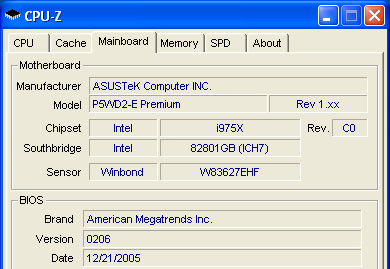

The memory, according to OCZ, is capable of running at 667MHz with CL 3-3-3-15 timings. The first measurements were taken with the modules running with SPD.
- SPD
Serial Presence Detect (SPD) is information that describes the memory module's size, data width, speed, and voltage, and is stored on the memory module itself. When your computer boots up, the BIOS uses this information to configure the installed memory at maximum reliability and performance. This is also convenient for ordinary, everyday users, who may not want to be bothered with or don't know how to set the memory timings. If the timings are not set correctly, the computer may not start up at all or can cause exception errors in the operating system.
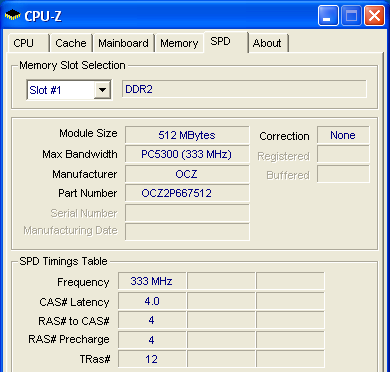

- 667MHz CL 3-3-3-12
Afterwards, we set the memory to its certified speed and timings, according to OCZ, which is 667MHz and CL 3-3-3-12. At this point, we should mention that although this is the certified setup for this memory, Memtest86+ reported an error during the sixth test.
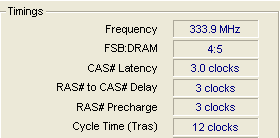
- 800MHz CL 4-4-4-15
We then decided to increase the timings a little, after getting errors with Memtest86+. The memory was set at 800MHz with timings of 4-4-4-15 and without over-clocking the processor.

- 870MHz CL 4-4-4-15
Finally, we over-clocked our processor and set the memory at 870MHz with timings of 4-4-4-15.

The reported memory bandwidth from Memtest for each setup, is given in the following table.
| Memtest86+ v1.65 Memory Bandwidth (MB/s) |
| 667- 4.4.4.12 (SPD) |
3177 |
| 667 - 3.3.3.12 |
3399 |
| 800 - 4.4.4.15 |
3478 |
| 870 - 4.4.4.15 |
3782 |
Here's a rundown of our testbed:
System Specifications
CPU: Intel Pentium 4 ED 3.73GHz
Cooler: Thermaltake Blue Orb II
Case: none
Motherboard: Asus P5WD2-E PREMIUM
Power supply: Thermaltake PurePower 520W
Memory: DDR2 PC2-5400 Platinum XTC Dual Channel 2x1GB
VGA: ASUS EAX1600XT Silent
Hard Disk Drive: WD800JD 80GB 7200RPM
OS: Windows XP Pro SP2
Drivers: 6.4
DirectX: v9.0c
Benchmarks & Applications used
Memtest86+-1.65
Sisoft Sandra 2005
PcMark05
Performance Test V5.0 ( PassMark)
Half Life 2 - VST
CPU-Z v1.33.1
3. SiSoftware Sandra 2005
 SiSoftware Sandra is a 32 and 64-bit Windows system analyser that includes benchmarking, testing and listing modules. It tries to go beyond other utilities to show you more of what is really going on under the hood so you draw comparisons at both a high and low-level in a single product.
SiSoftware Sandra is a 32 and 64-bit Windows system analyser that includes benchmarking, testing and listing modules. It tries to go beyond other utilities to show you more of what is really going on under the hood so you draw comparisons at both a high and low-level in a single product.
You can get information about the CPU, chipset, video adapter, ports, printers, sound card, memory, network, Windows internals, AGP, ODBC Connections, USB2, Firewire etc.
You can save/print/fax/e-mail/post/upload or insert into ADO/ODBC databases reports in text, HTML, XML, SMS/DMI or RPT format.
This version supports multiple sources of information gathering including: remote computers, PDAs, Smart Phones, ADO/ODBC databases or saved system reports.
All benchmarks are optimised for both SMP & SMT (Hyper-Threading), up to 32/64 CPUs depending on the platform.
Memory Bandwidth Benchmark
Tests how your memory sub-system compares to other systems with the same or similar memory in other systems. The benchmark is based on the well-known STREAM memory bandwidth benchmark. (Higher is better, i.e. better performance).
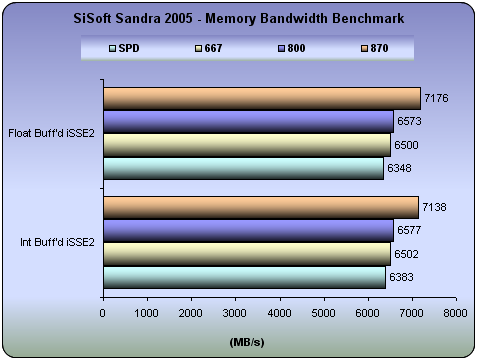
| 667 |
4.4.4.12 (SPD) |
| 667 |
3.3.3.12 |
| 800 |
4.4.4.15 |
| 870 |
4.4.4.15 |
The lower timings, from 4-4-4-12 to 3-3-3-12, with the memory running at the same speed of 667 MHz, reported better performance. Setting the memory frequency to 870 MHz will greatly boost performance.
Cache & Memory Benchmark
Tests how your CPU cache and memory sub-system(s) compares to other systems with the same or similar CPU & memory in other systems. The benchmark is based on the Memory Bandwidth Benchmark test.
Combined Index: is a composite figure representing the overall performance rating of the entire Cache-Memory performance in terms of MB/s. The value is the logarithmic average of all the results for the entire address space. (Higher is better, i.e. better performance)
For block sizes that could not been tested - the average of previous blocks is used, thus the size of the memory (as long as it is not comparable to largest cache size) is not significant; all cache sizes are significant - larger caches will result in a higher index.
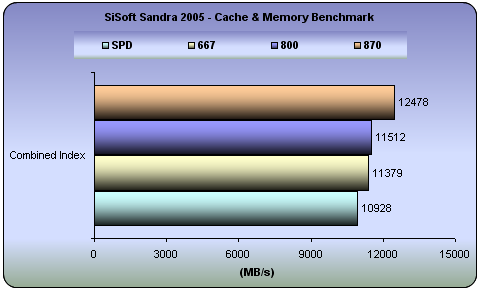
Similar results here also. While lower timings make a difference initially, overclocking does so even more.
Speed Factor: is a figure representing the speed differential between the CPU’s cache and memory. The value is the ratio of the fastest cache (i.e. L1) bandwidth to the main memory bandwidth. (Lower is better, i.e. the memory is not very much slower than the CPU’s cache).
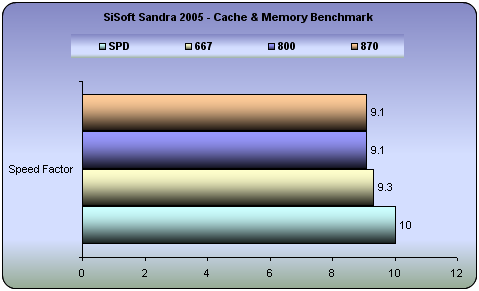
It seems that when running the memory at either 800MHz or 870MHz, but with timings of 4-4-4-15 on both occasions, produces the best results.

4. PCMark05
PCMark05 is an application-based benchmark and a premium tool for measuring overall PC performance. It uses portions of real applications instead of including very large applications or using specifically created code. This allows PCMark05 to be a smaller installation as well as to report very accurate results. As far as possible, PCMark05 uses public domain applications whose source code can be freely examined by any user.

PCMark05 includes 4 categorized suites for benchmarking your computer. These include CPU, Graphics, Memory and a Hard Disk Drive benchmark. In our case, we selected to run only the Memory test suite.
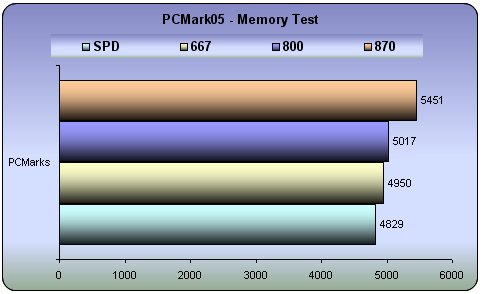
| PCMark05 Memory Test |
SPD |
667 |
800 |
870 |
| Memory Read 16MB (MB/s) |
7358.776 |
7500.262 |
7894.195 |
8519.528 |
| Memory Read 8MB (MB/s) |
7649.392 |
7927.326 |
8199.440 |
8937.835 |
| Memory Read 192KB (MB/s) |
28940.496 |
29564.777 |
29406.506 |
32044.211 |
| Memory Read 4KB (MB/s) |
49192.688 |
49354.047 |
49284.203 |
53624.445 |
| Memory Write 16MB (MB/s) |
5307.604 |
5344.736 |
5373.209 |
5807.667 |
| Memory Write 8MB (MB/s) |
5311.978 |
5351.058 |
5360.984 |
5832.374 |
| Memory Write 192KB (MB/s) |
12588.395 |
12599.184 |
12610.131 |
13656.597 |
| Memory Write 4KB (MB/s) |
12615.983 |
12625.090 |
12619.238 |
13762.777 |
| Memory Copy 16MB (MB/s) |
5360.463 |
5366.804 |
5757.735 |
6229.953 |
| Memory Copy 8MB (MB/s) |
5015.526 |
5482.573 |
5469.230 |
5928.533 |
| Memory Copy 192KB (MB/s) |
10181.093 |
10432.290 |
10424.120
|
11342.111 |
| Memory Copy 4KB (MB/s) |
12638.539 |
12622.229 |
12600.479 |
13707.834 |
| Memory Latency 16MB (MAccesses/s) |
10.030 |
10.635 |
10.996 |
11840 |
| Memory Latency 8MB (MAccesses/s) |
10.462 |
11.012 |
11.380 |
12530 |
| Memory Latency 192KB (MAccesses/s) |
147.752 |
159.409 |
159.405 |
173320 |
| Memory Latency 4KB (MAccesses/s) |
934.302 |
934.301 |
934.312 |
1015923 |
Better overall performance with lower timings, although not too great. The scene changes and the PCMarks are even higher with the overclocked settings of 870/4-4-4-15.

5. Performance Test v5.0
 Passmark PerformanceTest is an award winning PC hardware benchmark utility that allows everybody to quickly assess the performance of their computer and compare it to a number of standard 'baseline' computer systems.
Passmark PerformanceTest is an award winning PC hardware benchmark utility that allows everybody to quickly assess the performance of their computer and compare it to a number of standard 'baseline' computer systems.
Twenty seven standard benchmark tests are available in seven test suites plus there are five advanced testing windows for custom benchmarking. CPU Tests, 2D Graphics Tests, 3D Graphics Tests, Disk Tests, Memory Tests and CD/DVD Tests. In our case we selected the Memory suite Tests.
- Memory Benchmarks
This suite contains a number of tests that exercise the memory sub-system of the computer. (Random Access Memory- RAM)
Memory - Allocate small block
This test measures the time taken to allocate & free small zeroed memory blocks (around 100KB block size)
Memory - Cached
This test measures the time taken to read a small block of memory. The block is small enough to be held entirely in cache (if one is present)
Memory - UnCached
This test measures the time taken to read a large block of memory. The block is too large to be held in cache.
Memory - Write
This test measures the time taken to write information into memory.

Similar performance between SPD, 667 and 800, but the difference is noticeable at 870.
- Advanced Memory Benchmark
Memory Speed Per Access Step Size
The first test type, ‘Memory Speed Per Access Step Size’ accesses a large block, of memory in various sized steps. First, it runs through the block of memory sequentially, accessing every value. Next it runs through the same block again, except this time it accesses every second value. On this occasion, it runs through the block twice in order to access the same amount of data as the initial step. Next it runs through the same block again, except this time it accesses every fourth value and so makes four passes. And so on, until a certain maximum step size is reached.
The size of the block of memory used for this test is one quarter the amount of system RAM. The size of the steps varies from 1 (continuous sequential access), to one quarter the size of the block of memory ( i.e. one sixteenth of the system RAM ).
| Memory Speed (MB/Sec. per Step Size) |
SPD |
667 |
800 |
870 |
| OCZ PC2-5400 |
| Block Read Speed |
40.10 |
40.35 |
40.72 |
44.41 |
| Block Write Speed |
25.66 |
26.17 |
26.81 |
29.20 |
Memory Speed Per Block Size
When a computer program wants to use a section of memory to store data, it makes a request to Windows for the amount of memory it requires. Windows allocates the memory to the program ( unless system resources are very low ) and returns to the requesting program the address of the first memory slot in the allocated block. It is possible that some programs may request very large amounts of memory. The ‘Memory Speed Per Block Size’ test like the ‘Memory Speed Per Access Step Size’ test, is composed of many steps. During each step of the test, PerformanceTest requests a block of memory and runs through the block measuring the average access time. However on each subsequent step the size of the requested memory is increased, until finally a block close to the size of the system RAM is requested. In this way it is possible to observe the different access speeds for the different sizes of blocks.
Typically it is possible to see very fast memory access for blocks which are small enough to fit entirely into the L2 RAM cache, and slower access times for larger blocks accessed from main RAM. In the case where system resources are low, swapping to the disk may even be required for very large blocks.
| Memory Speed (MB/Sec. per Block Size) |
SPD |
667 |
800 |
870 |
| OCZ PC2-5400 |
| Block Read Speed |
430.0 |
431.63 |
431.88 |
470.02 |
| Block Write Speed |
298.57 |
299.27 |
298.98 |
325.58 |
There is huge gain when the RAM is overclocked. When not overclocking, the performance as reported by Passmark, is the same no matter whether the memory is running at 667MHz or 800MHz.

6. Half Life 2
 Half life 2 is no doubt the most anticipated PC game of all time.
Half life 2 is no doubt the most anticipated PC game of all time.
Physics - From pebbles to water to 2-ton trucks respond as expected, as they obey the laws of mass, friction, gravity, and buoyancy.
Graphics - Source's shader-based renderer, like the one used at Pixar to create movies such as Toy Story® and Monster's, Inc.®, creates the most beautiful and realistic environments ever seen in a video game.
AI - Neither friends nor enemies charge blindly into the fray. They can assess threats, navigate tricky terrain, and fashion weapons from whatever is at hand.
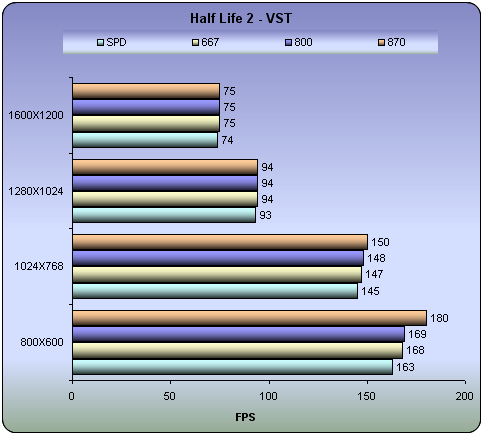
There is no actual difference in performance in a games environment, unless you overclock the entire system. Similar performance for the memory when running at 667MHz and 800MHz.

7. Conclusion
After having only recently reviewed the Gold GX XTC modules, we found that the Platinum XTC Dual Channel had exactly the same design, but with platinum employing the honeycomb design for better airflow. It is quite impressive construction that promises much more than just improving the look inside your case.
The overall performance of the DDR2 PC2-5400 Platinum XTC Dual Channel 2x512MB was good at all speeds. Although it is certified at 667MHz, we managed to run the modules at 870MHz but with a compromise in timings, from 3-3-3-12 to 4-4-4-15.
The modules we received, produced good performance in PCMark05, achieving 5451 PCMarks. While with SiSoft Sandra 2005, the performance was an impressive 7138MB/s and 7176MB/s in the RAM Bandwidth Integer and Floating Point benchmarks respectively, and in the Combined Index, the reported 12478MB/s was quite good.
In games, the increased memory speed in combination with an overclocked CPU will increase the frame rate, as happened in our HL2 test. However, in such an situations, it is mostly the VGA card that will make the difference.

At the time of this review, the price for the DDR2 PC2-5400 Platinum XTC Dual Channel 2x512MB was US$140 from newegg.com. A good price with good performance in combination with the lifetime warranty, makes this product a great buy.
